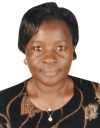PAUL ISABIRYE
ID:
|
An Analysis of the drivers of Antenatal Care leaks along the ANC cascade in Uganda: A case study of RHITES Implementing Mechanisms
REFNo: HS876ES
a. To identify the causes of dropout of mothers from antenatal care service delivery in Uganda.
i. To identify the individual factors that drive drop out of mothers from ANC services.
ii. To identify socio-cultural factors that influence mothers to drop out of antenatal care along the ANC cascade.
iii. To examine the institutional factors that drive loss of clients in ANC care across the ANC cascade.
b. To determine the level of completion of four ANC visits and more than four ANC visits among mothers attending antenatal care
c. To identify the approaches used by the different health institutions to minimize loss of mothers from antenatal care across the ANC cascade.
|
Uganda |
2020-09-02 |
2023-09-02 |
Medical and Health Sciences |
|
Non-degree Award |

|
Rita Nakalega
ID: UNCST-2019-R000599
|
PEER-DELIVERED HIV SELF-TESTING AND PrEP FOR YOUNG WOMEN IN UGANDA
REFNo: HS845ES
1. To assess the feasibility and acceptability of using peer-delivered HIVST and oral PrEP to young women in Uganda.
2. To explore how peer-delivery of HIVST and PrEP influences PrEP persistence among young wome
|
Uganda |
2020-08-28 |
2023-08-28 |
Medical and Health Sciences |
|
Degree Award |

|
Diana Nabbumba Erinah
ID:
|
Exploring the systemic nature of social care provision and expectations for older people in rural Uganda: A transformative qualitative study
REFNo: HS322ES
This study aims to investigate the current state of social care for older people in rural areas of Uganda. It will establish who is responsible for aged care in rural Uganda, the challenges and gaps in the current social care system and provide recommendations to address these gaps and challenges. The study is significant because it will contribute to the body of knowledge of social care in rural areas of developing countries. More specifically, this research will increase awareness of the plight of older people in seeking social care, and allow for recommendations to be made to key relevant stakeholders
|
Uganda |
2020-08-26 |
2023-08-26 |
Medical and Health Sciences |
|
Degree Award |

|
Adeodata Rukyalekere Kekitiinwa
ID: UNCST-2019-R000799
|
Project Evaluation Protocol for the ACE-FORT Project: Entitled; “Accelerating Epidemic Control in Fort Portal Region in the Republic of Uganda under the President’s Emergency Plan for AIDS Relief (PEPFAR)â€
REFNo: HS740ES
i) To determine the extent to which the project; a) Increases the proportion of PLHIV with known HIV status by 2020, b) Increases the proportion of people diagnosed with HIV accessing ART by 2020, c) Increases proportion of people receiving ART who are virally suppressed by 2020, d) Achieves coverage of high impact combination prevention interventions in scale-up districts by 2020, e) Provides Healthy, Safe, Stable, Schooled, and case management services along the Continuum of Response to eligible OVC and their families and graduate families out of Vulnerability by 2023, f) Strengthens regional and district governance and systems for sustained epidemic control by 2023.
ii) To Assess the relevance of; a) Prevention services in reducing the incidence of HIV in Fort portal region, b)Treatment and care services in reducing HIV related morbidity and mortality, c) OVC services in reducing the vulnerability of families with HIV.
iii) To assess the potential for sustainability of project components, results achieved and other efforts aimed at achieving HIV epidemic control in Fort Portal region.
iv) To assess the cost of; a) identifying new HIV positive children and adults, b) retaining HIV positive clients in care, c) graduating OVC’s from vulnerability.
|
Uganda |
2020-08-26 |
2023-08-26 |
Medical and Health Sciences |
|
Non-degree Award |

|
ELIZABETH EKIRAPA-KIRACHO
ID: UNCST-2021-R013443
|
Activity-Based Costing and Management of HIV Services at the Facility Level in Uganda
REFNo: HS796ES
The main objective of this study is to obtain routine and accurate cost information on the provision of HIV and health services at the facility level and to use this information to effectively allocate resources, improve monitoring efforts, and increase efficiency. Specifically to;
1. To collect primary data on expenditure, utilization and service delivery of core HIV services from health facility providers and clients.
2. To collect secondary data on service delivery and HIV expenditures for core HIV services from health facilities.
|
Uganda |
2020-08-26 |
2023-08-26 |
Medical and Health Sciences |
|
Non-degree Award |

|
molly naisanga
ID: UNCST-2023-R005602
|
THE IMPACT OF KNOWLEDGE, PERCEPTIONS AND BELIEFS OF PATIENTS’ ABOUT ANTICOAGULATION AND THEIR ASSOCIATION WITH INTERNATIONAL NORMALIZED RATIO CONTROL IN UGANDA AND SOUTH AFRICA
MIXED METHODS STUDY
REFNo: HS609ES
1. To describe the relationship between patients’ beliefs about warfarin and INR control.
2. To explore patients’ knowledge, perceptions and beliefs about warfarin treatment in Ugandan and South African patients receiving anticaogulation.
3. To explore the knowledge, perceptions and practices of Ugandan and South African health care providers about provision of warfarin.
|
Uganda |
2020-08-24 |
2023-08-24 |
Medical and Health Sciences |
|
Non-degree Award |
.jpg)
|
Mohammed Lamorde
ID: UNCST-2019-R001293
|
An open-label, randomized, single intravenous dosing study to investigate the effect of fixed dose combinations of tenofovir/lamivudine or atazanavir/ritonavir on the pharmacokinetics of remdesivir in Ugandan healthy volunteers
REFNo: HS654ES
Primary objectives
1. To assess the safety and tolerability of single intravenous doses of remdesivir in adult healthy volunteers
2. To evaluate the intracellular pharmacokinetics of single dose intravenous remdesivir with or without co-administration of oral fixed-dose combination tenofovir/lamivudine with patients serving as their own controls
Secondary objectives
1. To evaluate the difference in plasma and intracellular pharmacokinetics of intravenous remdesivir among healthy volunteers receiving tenofovir/lamivudine versus healthy volunteers receiving tenofovir/lamivudine plus atazanavir/ritonavir tablets.
2. To generate a population pharmacokinetic model to describe inter-individual variability in intracellular pharmacokinetics of remdesivir
|
Nigeria |
2020-08-24 |
2023-08-24 |
Medical and Health Sciences |
|
Non-degree Award |

|
DEUS KAMYA
ID:
|
In-vitro activity of mycobacteriophages against Mycobacterium tuberculosis biofilms
REFNo: HS774ES
1. To characterize the lytic activity of mycobacteriophages using Mycobacterium smegmatis mc2155 as host bacterium
2. To determine mycobacteriophage host range on a panel of 50 clinical isolates of Mycobacterium tuberculosis
3. To determine the inhibitory and disruptive effect(s) of mycobacteriophages on Mycobacterium tuberculosis-biofilms
|
Uganda |
2020-08-24 |
2023-08-24 |
Medical and Health Sciences |
|
Degree Award |

|
CATHERINA NAZZIWA
ID:
|
Perspectives on Genetic Research and
Curative Therapies for Sickle Cell Disease
REFNo: SS520ES
The main objective of this study is to assess perspectives of diverse sickle cell disease stakeholders in Uganda regarding participation in genetics research and curative therapies for sickle cell disease, and to identify the related key ethical, social and cultural issues.
|
Uganda |
2020-08-24 |
2023-08-24 |
Social Science and Humanities |
|
Degree Award |
.jpg)
|
CATHERINE ABBO
ID:
|
Incorporating mental health and psychosocial support in the Ugandan Police Child and Family Protection Department toll free line to address sexual and gender-based violence (SGBV) complaints.
REFNo: HS791ES
1. To explore the understanding of TFLOs regarding MHPSS needs of complainants of SGBV.
2. To develop and implement a mental health and psychosocial support training for 20 TFLOs working in Kampala and Wakiso Districts.
3. To conduct an evaluation of the training programme among the TFLOs.
|
Uganda |
2020-08-24 |
2023-08-24 |
Medical and Health Sciences |
|
Degree Award |

|
Gilbert Habaasa
ID:
|
Death registration completeness, gendered Social norms and Behavioural practices affecting death registration in Uganda
REFNo: SS539ES
i. To establish the prevalence of death registration in HDSS sites of Uganda (absolute number of deaths registered).
ii. To find out the level of data quality for death registration in HDSS sites of Uganda
(death registration completeness, timeliness of death registration).
iii. To generate gendered vital statistics using existing death data in HDSS sites of Uganda (Age Specific Mortality Rates, Life expectancy at birth and cause of death by age and gender)
iv. To find out the gendered social norms and behavioral practices that lead to under-registration of deaths in Uganda.
|
Uganda |
2020-08-24 |
2023-08-24 |
Social Science and Humanities |
|
Non-degree Award |

|
Faith Sebuliba Rosemary Kasumba
ID:
|
To explore Nursing Students Readiness to Learn in a Technology Enhanced Environment in Degree Completion Programs in Institutions of Higher Education in Uganda
REFNo: HS716ES
i.Describe nursing student self-efficacy of technical competencies that promote, their readiness to learn in technology enhanced environments.
ii.Describe personal attributes associated with nursing students’ readiness to learn in technology enhanced environments.
iii.Determine institutional support that promote nursing students readiness to learn in technology enhanced environments.
iv.Determine nursing students’ perspectives regarding their readiness to learn in a technology enhanced environment.
|
Uganda |
2020-08-21 |
2023-08-21 |
Medical and Health Sciences |
|
Degree Award |

|
Noah Kiwanuka
ID: UNCST-2021-R010125
|
Bio ethical Issues in the Use of Mobile Phone Data for Public Health Research in Uganda
REFNo: HS717ES
1. To perform a systematic review of the literature to document the current state-of-evidence on the ethics related to the use of mobile phone CDRs and data from other mobile devices for public health research in Africa. We will search published and unpublished literature to identify what is known and gaps in knowledge about ethics of CDRs.
2. To assess perception, attitudes and concerns of key stakeholders in relation to the utilization of CDRs for public health research in Uganda. We will conduct a mixed- methods study using key informant interviews and focus group discussions and quantitative surveys to gather information about ethical concerns, opinions, and suggestions from a range of selected stakeholders. The stakeholders will include patients, community members, health workers, health researchers, government officials, telecommunication companies, Institutional Review Boards/Ethics Committees, academic faculty, research organizations, ICT regulatory boards among others.
|
Uganda |
2020-08-21 |
2023-08-21 |
Medical and Health Sciences |
|
Non-degree Award |

|
Andrew Mujugira
ID: UNCST-2019-R000871
|
Same-Day PrEP Initiation and Sexual Health for Transgender Women
REFNo: HS772ES
1) Evaluate the feasibility and acceptability of same-day F/TAF PrEP initiation among African trans women
2) Characterize F/TAF persistence and test the impact of drug level feedback among African trans women taking PrEP
3) Explore how self-care interventions for sexual health influence HIV/STI prevention choices among African trans women and their sexual partners
|
Uganda |
2020-08-21 |
2023-08-21 |
Medical and Health Sciences |
|
Non-degree Award |

|
Simon Peter Katongole
ID:
|
Strengthening health systems for quality health care: case study of misdiagnosis among hospitalized patients in general hospitals in Uganda
REFNo: HS826ES
To examine health system factors associated with misdiagnosis for improving health care quality in general hospitals in Uganda.
Specific objectives
a) To determine the prevalence of misdiagnosis for patients admitted to general hospitals in Uganda.
b) To examine association between health system and individual-related predictors with misdiagnosis in general hospitals in Uganda.
c) To explore health workers’ perspectives of the predictors of misdiagnosis among admitted patients in general hospitals in Uganda.
d) To assess the financial cost of misdiagnosis among inpatients in hospitals in Uganda.
|
Uganda |
2020-08-21 |
2023-08-21 |
Medical and Health Sciences |
|
Degree Award |

|
Richard Muhindo
ID:
|
Fighting COVID-19: Assessment of Health Systems Support for Psychosocial Preparedness and Needs of Health Workers Providing Essential Patient Care in Uganda
REFNo: HS715ES
3. To develop and propose a model for psychosocial and emotional support for healthcare professionals working in contexts of contagious disease outbreaks ,2. To examine health systems institutional capacity to provide psychosocial and emotional support to health professionals providing essential care to people with COVID-19.,1. To describe the psychosocial preparedness and of healthcare professionals providing essential care to people with COVID-19,To assess the health systems’ support for psychosocial preparedness and needs of healthcare professionals providing essential care for people with COVID-19 in Uganda,
|
Uganda |
2020-08-20 |
2023-08-20 |
Medical and Health Sciences |
|
Non-degree Award |

|
Japheth Kwiringira Nkiriyehe
ID: UNCST-2019-R000408
|
GEO-SOCIO, CAPACITY INTERSECTIONS ON HEALTH CARE OUTCOMES IN KALANGALA ISLANDS, UGANDA
REFNo: SS506ES
Main Objective
To explore how intersections of social, geographical and health provider capacity influence access to health care and outcomes.
Specific Objectives
1. Investigate the relationship between geo-social factors, health care providers’ capacity and health care access (supply and demand factors) produce health outcomes.
2. Investigate the relationship between geo-social factors, health care providers’ capacity and utilisation of health care services.
|
Uganda |
2020-08-20 |
2023-08-20 |
Social Science and Humanities |
|
Non-degree Award |

|
Hawa Nalwoga
ID:
|
Improving access to prompt and adequate cancer care: Liquid biopsy biobank to promote early cancer diagnosis, screening and monitoring
(Makerere University Liquid Biopsy Biobank Project (MakLBBP)
REFNo: HS808ES
1. To create a liquid biopsy biobank of blood samples obtained from Ugandan patients with any of the five cancers: cervical cancer, breast cancers, prostate, colorectal and oesophageal cancers and from normal control participants
2. To assess awareness, knowledge and opinion of cancer patients and health volunteers regarding causes of cancer, cancer diagnosis and management of cancer
Secondary specific objectives
3. To explore likely acceptability and perceptions of cancer patients and caregivers towards biospecimen donation for biobanking to use in cancer research at Hoima, and Jinja Regional Referral hospitals and Uganda Cancer Institute
|
Uganda |
2020-08-20 |
2023-08-20 |
Medical and Health Sciences |
|
Non-degree Award |

|
Matt Baillie Smith
ID:
|
Skills acquisition and employability through volunteering by displaced youth in Uganda
REFNo: SS447ES
Research Objectives
1.To conceptualize the relationship between different forms of volunteering and the acquisition of skills by Ugandan refugee youth.
2. To map and explain where and how young refugees in Uganda are engaged in volunteering.
3. To identify and understand the factors that shape participation in volunteering by refugee youth in Uganda.
4. To assess the impact of volunteering by refugee youth in Uganda on employability and achieving meaningful work.
Research Questions
1. How is volunteering understood by young refugees in Uganda and how does this vary between settings (e.g. urban or rural settlement), and by factors such as gender, age, sexuality, nationality and ethnicity?
2. Where and how do young refugees in Uganda engage in volunteering?
3. What factors shape young refugees’ participation in volunteering in Uganda?
4. How have volunteering experiences shaped the employment trajectories of refugees who have found meaningful work in Uganda and how does the impact of volunteering on employability vary by setting, and by factors such as gender, age, sexuality, ethnicity and nationality?
|
UK |
2020-08-19 |
2023-08-19 |
Social Science and Humanities |
|
Non-degree Award |

|
Terence Odoch Amoki
ID:
|
Understanding Campylobacteriosis transmission dynamics using "One Health", computational and systems dynamics modeling approaches
REFNo: HS663ES
The specific objectives are:
i. Determine fecal occurrence of Campylobacter in children poultry and pigs
ii. Characterize Campylobacter from children pigs and poultry
iii. Describe relatedness of the Campylobacter isolates
iv. Develop transmission models for Campylobacter
v. Characterize phenotypic and genotypic antimicrobial resistance in Campylobacter organisms isolated from human’s poultry and pigs in Uganda
|
Uganda |
2020-08-19 |
2023-08-19 |
Medical and Health Sciences |
|
Non-degree Award |

|
| View |
|
Sort By: |
|
|
|
| |
|